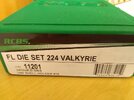This has been beat to death over the years. I'm new to reloading rifle and suffering from information overload. Reading and talking with people ad nauseam opens up more questions.
Looking for a "one stop shop" reloading manual recommendation please. I have one 20" AR is chambered in 5.56 and the other, a JP Wylde .223 rifle.
I have both .223 Remmington and military 5.56 brass range brass and about 1K rounds of .224 unloaded bullets.
Do people reload military brass? One person I know states that he scrapps military.
Will a 5.56 die "force" .223 brass into 5.56" dimension?
Would resized range brass be suitable to reload in .224?
The Hornady bullet comparator and OAL gauge tool looks essential.
https://www.youtube.com/watch?v=9pLfyWJrc9A
Any and all advice appreciated. Thank you!



